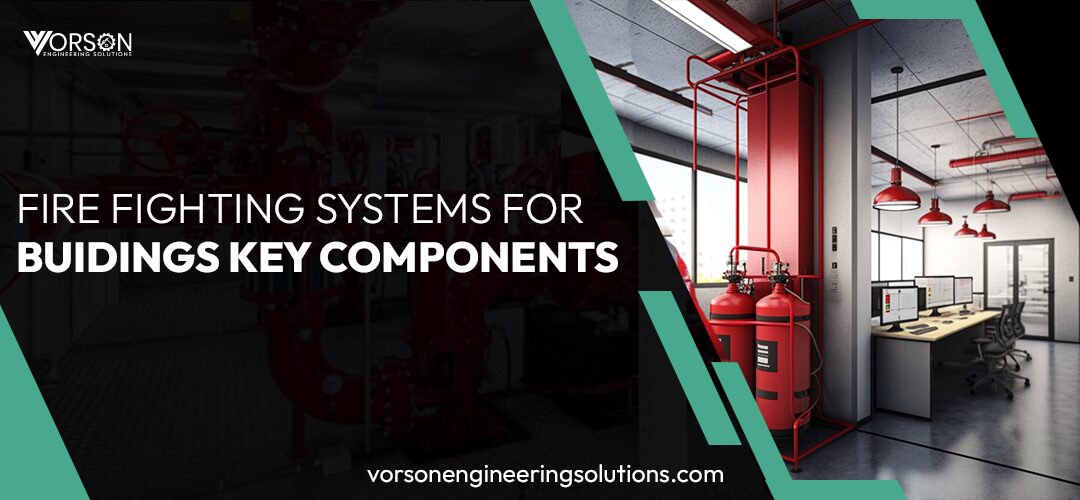Fire safety is a critical aspect of building design and maintenance. Firefighting systems protect lives and property and guarantee adherence to safety rules. These systems are made to find, manage, and put out flames before they can cause major damage. This article will discuss the main elements of firefighting systems in buildings and their indispensable importance for guaranteeing safety.
Importance of Fire Fighting Systems in Buildings
Firefighting systems are the first line of protection against fire crises. They depend on them to minimize damage, stop the spread of fire, and give residents the time to leave safely. Modern building designs must have an efficient firefighting system since it can make all the difference between a confined fire and a catastrophic event.
Key Components of Fire Fighting Systems in Buildings
Fire Alarm Systems
The main purpose of a fire alarm system is to detect smoke or heat and alert the building inhabitants and fire response teams. Early notice is essential for quick evacuation and emergency reaction. Usually, smoke detectors, heat detectors, manual call points, and alert sounders are fire alarm systems. Advanced systems could combine for coordinated reactions with other building management systems.
Sprinkler Systems
Designed to detect a fire, sprinkler systems release water automatically. This helps stop the fire from spreading until fire services arrive and helps contain it. The system requires sprinkler heads, a water supply, and a piping network. Temperature-sensitive sprinkler heads turn on when they reach a designated temperature.
Fire Extinguishers
Fire extinguishers are portable tools residents can use to extinguish minor flames before they spread. Any firefighting system depends on them. Water, foam, CO2, and dry powder extinguishers are among the several types of fires handled with different extinguishers. The building’s materials will determine the type of extinguisher to use.
Fire Hose Reels
Fire hose reels, particularly in big buildings, provide a constant water supply to fight flames. Unlike other firefighting tools, they can reach places that are challenging to access and are made for simple operation. The system comprises a water supply, a nozzle, and a hose reel. Usually robust, the hose can be swiftly unwounded in an emergency.
Fire Hydrants
Fire hydrants are external parts of the fire fighting system. They give firemen consistent access to water, making them indispensable for large-scale firefighting operations. Above-ground hydrants, valves, and subterranean pipes make up the hydrant system. Firefighters get water from the public or building’s water supply by connecting hoses to these hydrants.
Emergency and Exit Lighting
Emergency lighting guarantees that building residents may safely leave in case of a fire or a power outage. This system also includes exit signs, which direct people to the closest exit. The system includes illuminated exit signs, backup power sources (like generators or batteries), and emergency lights. These elements have to be arranged deliberately throughout the construction.
Integration of Fire Fighting Systems
All these elements are combined in an efficient firefighting system that operates without problems. For instance, the sprinkler system can be triggered, and the fire department can be informed when a smoke detector sets off the fire alarm. The integration guarantees a quick and coordinated reaction, reducing the damage and saving lives.
Maintenance and Regular Inspections
Regular maintenance and inspections are essential for maintaining the maximum functioning condition of firefighting equipment. Building owners and facility managers should plan periodic inspections to guarantee that every component conforms to local fire safety rules and is functional. Regular exercises and instruction for building residents on operating firefighting tools are also needed to improve the system’s efficiency.
Building firefighting systems is crucial for ensuring safety and avoiding fire-related calamities. Understanding the main elements of fire alarm systems, sprinkler systems, fire extinguishers, fire hose reels, fire hydrants, and emergency lighting helps one value each element in preserving lives and property. Maintaining the integrity of these systems depends on safe surroundings for regular inspections.
Vorson Engineering provides complete firefighting solutions and designs, installs and maintains fire safety systems catered to your building’s demands. It will help ensure your building has the best firefighting systems to protect assets and lives.



